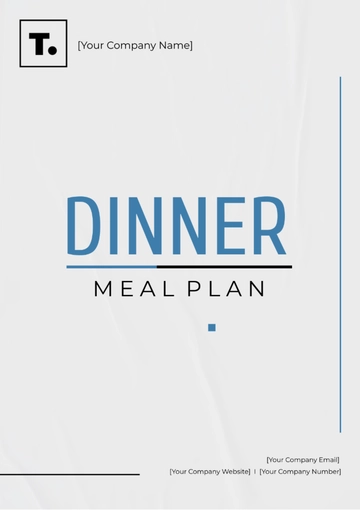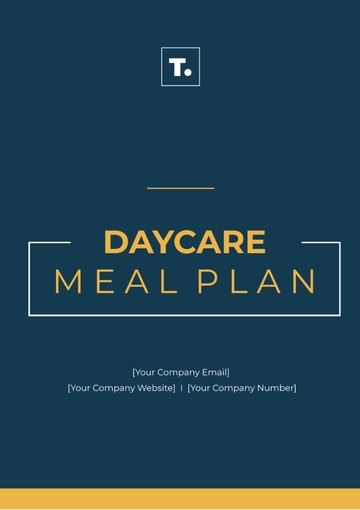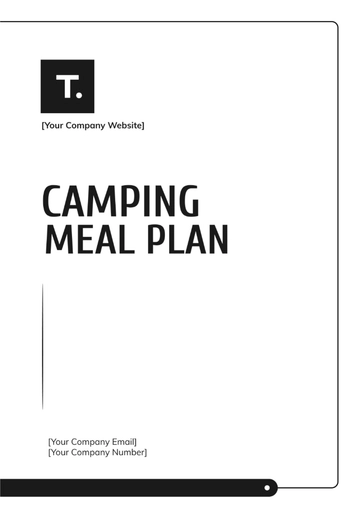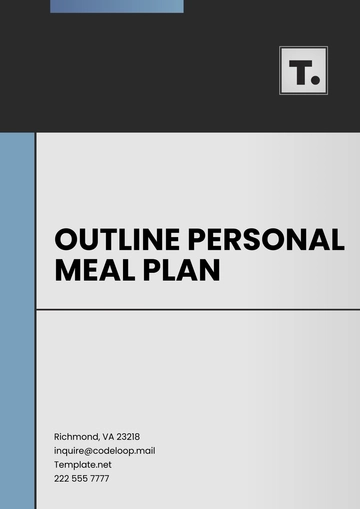Free Food Meal Plan

Prepared by: [Your Name]
I. Overview
This food meal plan is designed to support a high fiber and high protein diet, which is beneficial for promoting satiety, supporting muscle growth and repair, and maintaining digestive health. By incorporating a variety of fiber-rich foods and protein sources, this meal plan aims to provide balanced nutrition to meet dietary goals.
II. Objectives
Increase fiber intake to support digestive health and regulate blood sugar levels.
Boost protein intake to support muscle growth, repair, and overall health.
Provide a variety of nutrient-dense foods to meet daily nutritional needs.
III. Guidelines
Incorporate a balance of fiber-rich foods such as fruits, vegetables, whole grains, and legumes.
Include lean sources of protein such as poultry, fish, tofu, tempeh, legumes, and low-fat dairy.
Limit processed foods, refined grains, and added sugars to promote overall health.
Drink plenty of water throughout the day to support digestion and hydration.
IV. Sample Meal Plan
Time | Meal | Option A | Option B |
|---|---|---|---|
Breakfast | |||
Meal | Greek yogurt parfait with berries and nuts | Scrambled tofu with spinach and whole-grain toast | |
Nutritional Benefits | High in protein, calcium, and antioxidants | Plant-based protein source, fiber-rich, and vitamins | |
Ingredients | Greek yogurt, Mixed berries, Nuts | Firm tofu, Spinach, Whole grain bread | |
Instructions | Layer yogurt with berries and nuts in a glass, and enjoy a cold | Cook tofu with spinach, and serve with toast | |
Morning Snack | |||
Snack | Apple slices with almond butter | Cottage cheese with sliced cucumber | |
Nutritional Benefits | Fiber from apple, protein and healthy fats from almond butter | High protein and calcium, hydrating from cucumber | |
Ingredients | Apple, Almond butter | Cottage cheese, Cucumber | |
Instructions | Spread almond butter on apple slices, enjoy | Serve cottage cheese with cucumber slices | |
Lunch | |||
Meal | Quinoa salad with grilled chicken and vegetables | Lentil soup with whole grain roll | |
Nutritional Benefits | High fiber from quinoa and vegetables, protein from chicken | Plant-based protein and fiber-rich from lentils, whole grains | |
Ingredients | Quinoa, Grilled chicken breast, Mixed vegetables | Lentils, Carrots, Celery, Onion, Whole grain roll | |
Instructions | Combine cooked quinoa, grilled chicken, and vegetables in a bowl | Prepare lentil soup and serve with whole grain roll | |
Afternoon Snack | |||
Snack | Hummus with carrot and celery sticks | Protein bar with nuts and seeds | |
Nutritional Benefits | Protein and fiber from hummus, vitamins and minerals from vegetables | Convenient source of protein, fiber, and nutrients | |
Ingredients | Hummus, Carrot, Celery | Protein bar, Nuts, Seeds | |
Instructions | Dip carrot and celery sticks in hummus, enjoy | Enjoy a protein bar with nuts and seeds | |
Dinner | |||
Meal | Grilled salmon with quinoa and steamed broccoli | Black bean and vegetable stir-fry with brown rice | |
Nutritional Benefits | Omega-3 fatty acids, protein, and fiber from salmon and quinoa | Plant-based protein and fiber from black beans, vegetables, and brown rice | |
Ingredients | Salmon fillet, Quinoa, Broccoli | Black beans, Mixed vegetables, Brown rice | |
Instructions | Grill salmon, cook quinoa, and steam broccoli until tender | Stir-fry black beans and vegetables serve with brown rice |
V. Additional Tips
Prepare healthy snacks in advance to avoid reaching for unhealthy options when hunger strikes.
Be mindful of portion sizes, especially with calorie-dense foods, to prevent overeating.
Aim to include a source of protein, fiber-rich carbohydrates, and healthy fats in each meal to promote satiety and balanced nutrition.
VI. Nutritional Guidelines
A. Fiber
Aim for a daily intake of at least 25 grams for women and 38 grams for men to support digestive health and reduce the risk of chronic diseases such as heart disease and diabetes. Incorporate fiber-rich foods such as fruits, vegetables, whole grains, legumes, nuts, and seeds into your meals and snacks.
B. Protein
Consume a variety of protein sources to meet your daily protein needs, which may vary depending on factors such as age, gender, and activity level. Aim for approximately 0.8 grams of protein per kilogram of body weight per day, or higher if you are physically active or looking to build muscle. Good sources of protein include lean meats, poultry, fish, eggs, dairy products, tofu, tempeh, legumes, and quinoa.
C. Balanced Nutrition
Focus on eating a balanced diet that includes a variety of nutrient-dense foods from all food groups. Aim to fill your plate with colorful fruits and vegetables, whole grains, lean proteins, and healthy fats. Limit processed foods, refined grains, added sugars, and unhealthy fats, and prioritize whole, minimally processed foods whenever possible.
D. Consistency
Consistency is key to achieving and maintaining a healthy lifestyle. Plan your meals and snacks ahead of time, and make healthy choices a priority in your daily routine. Remember that small, sustainable changes over time can lead to long-term success in reaching your health and nutrition goals.
VII. Conclusion
This high-fiber and high-protein meal plan offers a variety of delicious and nutritious options to support your health and dietary goals. By following these guidelines and incorporating the suggested meal options, you can enjoy satisfying meals while nourishing your body with essential nutrients.
- 100% Customizable, free editor
- Access 1 Million+ Templates, photo’s & graphics
- Download or share as a template
- Click and replace photos, graphics, text, backgrounds
- Resize, crop, AI write & more
- Access advanced editor
Take the guesswork out of meal prep with our Food Meal Plan Template, available at Template.net. Whether you're a culinary enthusiast or a novice in the kitchen, this customizable tool makes planning effortless. Download and print your plan to stay organized. Editable in our AI Editor Tool, it adapts to your culinary preferences conveniently.





























